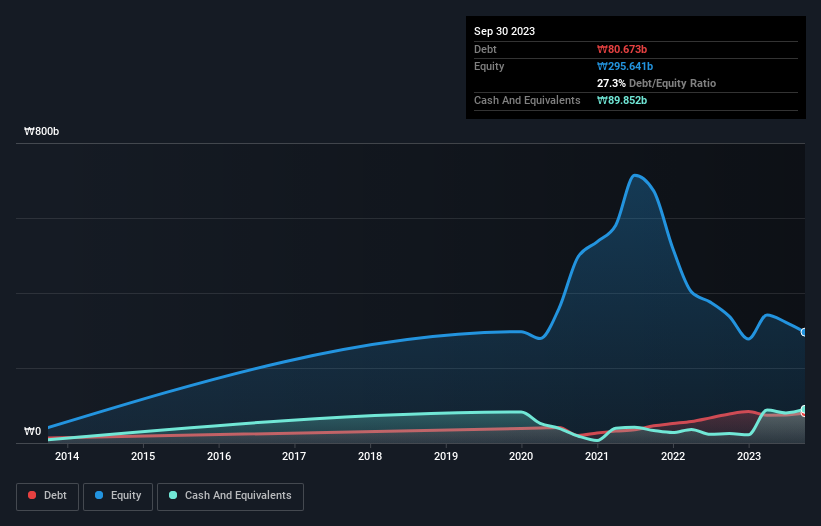- South Korea
- /
- Biotech
- /
- KOSDAQ:A095700
Genexine (KOSDAQ:095700) Has Debt But No Earnings; Should You Worry?

Some say volatility, rather than debt, is the best way to think about risk as an investor, but Warren Buffett famously said that 'Volatility is far from synonymous with risk.' So it might be obvious that you need to consider debt, when you think about how risky any given stock is, because too much debt can sink a company. We note that Genexine, Inc. (KOSDAQ:095700) does have debt on its balance sheet. But the real question is whether this debt is making the company risky.
When Is Debt Dangerous?
Debt is a tool to help businesses grow, but if a business is incapable of paying off its lenders, then it exists at their mercy. Ultimately, if the company can't fulfill its legal obligations to repay debt, shareholders could walk away with nothing. While that is not too common, we often do see indebted companies permanently diluting shareholders because lenders force them to raise capital at a distressed price. Of course, the upside of debt is that it often represents cheap capital, especially when it replaces dilution in a company with the ability to reinvest at high rates of return. When we think about a company's use of debt, we first look at cash and debt together.
View our latest analysis for Genexine
How Much Debt Does Genexine Carry?
As you can see below, at the end of September 2023, Genexine had ₩80.7b of debt, up from ₩77.5b a year ago. Click the image for more detail. But it also has ₩89.9b in cash to offset that, meaning it has ₩9.18b net cash.

A Look At Genexine's Liabilities
According to the last reported balance sheet, Genexine had liabilities of ₩72.3b due within 12 months, and liabilities of ₩25.1b due beyond 12 months. Offsetting this, it had ₩89.9b in cash and ₩12.5b in receivables that were due within 12 months. So it can boast ₩4.92b more liquid assets than total liabilities.
This state of affairs indicates that Genexine's balance sheet looks quite solid, as its total liabilities are just about equal to its liquid assets. So while it's hard to imagine that the ₩356.9b company is struggling for cash, we still think it's worth monitoring its balance sheet. Succinctly put, Genexine boasts net cash, so it's fair to say it does not have a heavy debt load! When analysing debt levels, the balance sheet is the obvious place to start. But you can't view debt in total isolation; since Genexine will need earnings to service that debt. So if you're keen to discover more about its earnings, it might be worth checking out this graph of its long term earnings trend.
In the last year Genexine had a loss before interest and tax, and actually shrunk its revenue by 67%, to ₩5.2b. To be frank that doesn't bode well.
So How Risky Is Genexine?
We have no doubt that loss making companies are, in general, riskier than profitable ones. And in the last year Genexine had an earnings before interest and tax (EBIT) loss, truth be told. And over the same period it saw negative free cash outflow of ₩52b and booked a ₩108b accounting loss. However, it has net cash of ₩9.18b, so it has a bit of time before it will need more capital. Overall, its balance sheet doesn't seem overly risky, at the moment, but we're always cautious until we see the positive free cash flow. There's no doubt that we learn most about debt from the balance sheet. However, not all investment risk resides within the balance sheet - far from it. For example Genexine has 3 warning signs (and 1 which can't be ignored) we think you should know about.
Of course, if you're the type of investor who prefers buying stocks without the burden of debt, then don't hesitate to discover our exclusive list of net cash growth stocks, today.
If you're looking to trade Genexine, open an account with the lowest-cost platform trusted by professionals, Interactive Brokers.
With clients in over 200 countries and territories, and access to 160 markets, IBKR lets you trade stocks, options, futures, forex, bonds and funds from a single integrated account.
Enjoy no hidden fees, no account minimums, and FX conversion rates as low as 0.03%, far better than what most brokers offer.
Sponsored ContentNew: Manage All Your Stock Portfolios in One Place
We've created the ultimate portfolio companion for stock investors, and it's free.
• Connect an unlimited number of Portfolios and see your total in one currency
• Be alerted to new Warning Signs or Risks via email or mobile
• Track the Fair Value of your stocks
Have feedback on this article? Concerned about the content? Get in touch with us directly. Alternatively, email editorial-team (at) simplywallst.com.
This article by Simply Wall St is general in nature. We provide commentary based on historical data and analyst forecasts only using an unbiased methodology and our articles are not intended to be financial advice. It does not constitute a recommendation to buy or sell any stock, and does not take account of your objectives, or your financial situation. We aim to bring you long-term focused analysis driven by fundamental data. Note that our analysis may not factor in the latest price-sensitive company announcements or qualitative material. Simply Wall St has no position in any stocks mentioned.
About KOSDAQ:A095700
Genexine
Operates as a biotechnology company that focuses on the development and commercialization of immunotherapies in South Korea and internationally.
Mediocre balance sheet low.
Market Insights
Community Narratives



